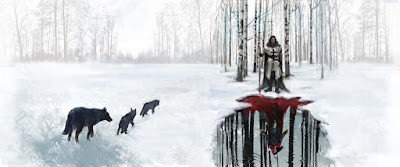Vincent van Gogh, Autoritratto (1888)
Who should arrange the list of new colors?
Since the arrival of industrial colors in the last century, artistic expression has radically changed in the hands of artists, as well as the amount and gradations of colors to be named one by one. Colors’ names have been replaced by pantone numbers designed to settle quickly in the offset printing presses, but which are now also among the choices of concept artists when they create what we now call ‘File Art’.
Hardware and software take the place of the traditional canvas and pigments. If 10 or 20 years ago we considered the fading of tones and colors as an impoverishment of the expressions capabilities, nowadays in this virtual reality, that by belonging to our existence has become real, technological innovation allows young artists and designers choices which were previously unthinkable, mash-ups of photography-action-painting that on the one hand have lost the characteristic aniline smell and taste; but they are able to give us the emotions of artistic forms forgotten in time, that today can awaken in order to allow us to continue on the aesthetic path. Examining for example the views of Roman ruins we can easily recognize the inspirations and shapes of Piranesi’s works rather than other Roman landscape painters, paintings by Dürer become animated in the game Assassin's Creed.
If the form is action we fear defining it as art
We can define the current one as a ‘middle period’, which certainly will lead to rapid developments during these first decades of the century, The application of technology in the era of artistic manua(bi)lity, gives high value to the work of concept artists who, being trained in academies and well experienced, skilfully depict both scenarios and game characters. A nodal period, in the making, clear and obscure in some respects, but certainly revealing as it is a carrier of new mechanisms such as the cooperation between D’Annunzio and Pastrone in Cabiria which led to the rise of cinema as art. Time was an extremely important element in kinetic and performance arts of last century. In photography – long trialed over its artistic value – timeframe is always set in the past. The shot, the print, be it analogue or digital, is always depicting a moment that is gone, a fragment representing what it used to be, so as in Barthes’ theorization. Cinema is the development of a specific moment in motion, but still the sum of many moments that were. The more we review a sequence, the more we enjoy its dynamism, nevertheless it will always be identical to itself. Videogame is interactive. The player becomes part of a dimension as much involved and engaging as the artist who created it. The gamer interacts physically and spiritually (through the controller, the PC keyboard or the portable console), he feels long lasting emotions, dives into, constantly shifting point of view. Therefore time in videogames is ‘distracted’, diversified, abstract and concrete. All forms of art implying or remembering motion have encountered serious obstacles in the process of recognition as arts; nowadays the videogame is undergoing the same process, both in the increased amount of forms and contents and in the observation of them by the critical eye of society.
Chi redigerà la lista dei colori nuovi?
“Chi mai potrà redigere la lista dei colori scomparsi?” chiede Jean Clair aprendo il capitolo “Mestiere, mito e memoria” dopo aver scorso le affermazioni di Julien Gracq nel constatare la laicizzazione dell’arte che fra i blu di Beato Angelico e i blu di Vermeer conduce a una despiritualizzazione della sua materia. Non solo l’espressione dell’arte muta tra le mani degli artisti per l’arrivo dei colori industriali del secolo scorso, ma quanti e quali colori chiamati uno a uno per nome, possiamo oggi aggiungere noi, si sono sostituiti con numeri di pantoni che vanno a comporre velocemente le stampe offset nelle tipografie ma soprattutto sono tra le scelte dei concept artists quando devono creare quella che ora noi chiameremo File Art. Se infatti fino a venti/dieci anni fa potevamo guardare la scomparsa di toni e colori come un impoverimento delle possibilità espressive, oggi, in questa parte di realtà virtuale ma pur sempre elemento della nostra esistenza e quindi reale nel nostro mondo, le innovazioni tecnologiche consentono ai giovani artisti e designer scelte impensabili prima, commistioni di fotografia-azione-pittura che da una parte non hanno più l’odore e il sapore delle aniline di una volta, ma sono in grado di ridarci emozioni formali di forme artistiche sopite nel tempo, forme interrotte che oggi possono risvegliarsi per permetterci di proseguire un cammino estetico. Prendiamo ad esempio gli scorci delle rovine romane e ritroviamo le ispirazioni e le forme riattualizzate delle opere di Piranesi o dei pittori paesaggisti romani, i dipinti di Dürer divenuti animati in Assassin's Creed.
Se la forma è azione ci fa paura chiamarla arte
Possiamo definire questo periodo di mezzo, che certamente porterà a sviluppi veloci in questi primi decenni del nuovo secolo, l’epoca dell’applicazione tecnologica nell’era della sua manua(bi)lità artistica, dando un valore al lavoro dei concept artists che sapientemente dipingono con capacità accademiche ben esperite scenari e personaggi del videogioco. Un periodo, questo, nodale, in divenire, chiaro e oscuro in certi aspetti, ma rivelatore, portatore di meccanismi nuovi, tanto quanto la collaborazione fra d’Annunzio e Pastrone in Cabiria portò alla nascita del cinema considerato come arte. Riflettiamo sul tempo, una componente importantissima nelle arti non solo cinetiche ma anche performative del secolo scorso. Nella fotografia – a lungo processata sulla sua artisticità – il tempo è sempre passato, lo scatto, la stampa, analogica o digitale non importa, è sempre un momento che non c’è più, è un punctum che rappresenta ciò che “è stato”, come afferma Barthes. Il cinema è lo sviluppo di un tempo preciso, in movimento, ma somma di tanti momenti che “sono stati”. Possiamo rivederlo e rivederlo ma pur assaporandone in un certo senso la dinamicità questa sarà sempre solo identica a se stessa. Il videogioco è interattivo. Il giocatore entra a far parte di una dimensione coinvolta e coinvolgente quanto l’artista che l’ha creato. Il giocatore interagisce spiritualmente e fisicamente (con il controller o la tastiera del pc o la console portatile), prova delle emozioni che perdurano, si immerge, cambia in continuazione il punto di vista. Il tempo del videogioco è dunque un tempo “distratto”, diversificato, astratto e concreto ogni volta che cambia lo sguardo e l’azione del giocatore nelle sue scelte.
Se tutte le arti contenenti o rimandanti a un movimento hanno avuto difficoltà a essere comprese come arti, ora il videogioco si trova ad affrontare lo stesso processo inteso sia come crescita di forme e contenuti sia come osservazioni degli stessi da parte della società.
Artemisia Gentileschi, Autoritratto come allegoria della Pittura (1638-39)






















